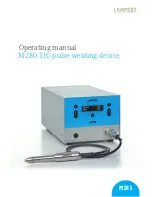
11
FIPALIFT Smart
>
The vacuum pump must be installed in a well ventilated area as it radiates heat. Ensure that
there is free space at least 300 mm around the pump and that no loose objects can cover the
pump's ventilation openings.
>
If the pump is not installed on the floor, ensure that it is installed securely in such a way that it
cannot fall down or tip over.
>
Make sure that the belt cover is installed.
>
The electrical installation may only be undertaken by a qualified electrician.
>
Remove the cover from the pump's vacuum inlet.
>
The pump may only be operated when the filter is connected.
>
Check the direction of rotation using the directional arrow on the electric motor and check
whether air is coming out of the silencer. The pump can be damaged if it is run in the wrong
direction.
>
If several FIPA tube lifters are installed, the vacuum pumps must be labelled in order to make
clear which pump is connected to which tube lifter.
>
The electrical cable must be laid through the cable bushings provided for such purpose.
(Please see the figure on page 7).
>
It is imperative also to note the operating instructions for the respective pumps.
The system may only be started up after a qualified electrician or electrically qualified
person has installed a safety device on the motor. If no safety device is installed on the
motor there is a risk of fire!
Installing the vacuum hose and air filter on the vacuum pump.
>
The air filter should be installed in an easily accessible place and it should also be clearly
identified which lifting device the filter is connected to. To start with, the vacuum hose must
be hung in the suspension system which the lifting unit is installed on (e.g. the FIPA crane
system or the FIPA jib crane or similar). Secure the vacuum hose to the top swivel joint of the
lifting unit and to the air filter.
>
Also secure the vacuum hose between the air filter and the vacuum pump.
NOTE!
The arrow
on the air filter points in the direction in which the hose leads to the vacuum pump.
>
Ensure that the vacuum hose is not pinched anywhere along its entire length or that it cannot
come into contact with things that could damage it.
Installing the compressed air operated vacuum pump (multi-chamber ejector)
>
Hang a compressed air hose in the suspension system which the lifting unit is installed on
(e.g. the FIPA crane system or the FIPA jib crane or similar). A G1/2 compressed air hose is
recommended.
>
Secure the compressed air hose to the vacuum pump's compressed air connection. The
compressed air connection has a G1/4 internal thread.
>
Ensure that the supplied compressed air is free of impurities and water. A water separator and
a solids filter must be installed between compressor and vacuum pump.
>
The lifting speed of the FIPALIFT Smart tube lifter with compressed air operated vacuum pump
is insufficient when the compressed air supplied is not at least 630 litres/minute at a pressure
of 6 bar. Restrictions, such as compressed air hoses that are too small or 90° angles in the line
must be avoided.








































